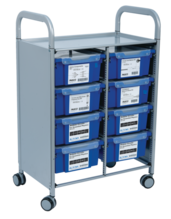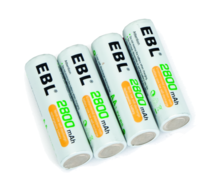











Eliminate the mess of wires with this ideal system for learning basic circuits. Can be used standalone, with a multimeter, or with PASCO sensors for real-time data collection.
See the Product Description for this item's included accessories.
See the Buying Guide for this item's required, recommended, and additional accessories.
Product Summary
These circuit modules are designed specifically for introductory circuits investigations. For students who have never wired a circuit, this modular system makes it easy for them to see their circuit physically laid-out exactly as it appears in their circuit diagram.
Each module connects mechanically to another by sliding the tabs into each other. It works on any tabletop. No special surface is required. To electrically connect two modules, students insert a jumper clip, which emphasizes that an electrical connection has been made. The large size of the modules (8 cm x 8 cm) enables all the students around the table to see and understand the completed circuit.
Choose the kit that's right for you!
This product, the Basic Modular Circuits Kit, is a lower cost, introductory set with fewer components than the Essential Physics Modular Circuits Kit. It does not include a Wireless Voltage Sensor or a Wireless Current Sensor Module. Use the Basic Kit to perform two of the experiments listed below. Add a Wireless Voltage Sensor and a Wireless Current Module to perform all five experiments.
The Essential Physics Modular Circuits Kit has more components, including the Wireless Current Module and Wireless Voltage Sensor. Choose the Essential Physics Kit to perform a wider range of experiments, including all five labs listed below.
Applications
- Kirchhoff's Laws
- Batteries and Bulbs Circuits
- Switches/Open/Closed Circuits
Perform These Experiments
- Resistance and Ohm’s Law
- Series/Parallel Circuits
- Circuits and Electricity
- Voltage and Batteries
- Electric Power and Energy
What's Included
- 4x Straight Module
- 2x Tee Module
- 4x Corner Module
- 30x Jumper Clips
- 2x Light Bulb Module (with bulb)
- 2x Battery Holder Module
- 2x AA-Cell Battery
- 1x SPST Switch Module
- 1x SPDT Switch Module
- 1x 0.33 F Capacitor Module
- 1x 33 Ω Resistor Module
- 1x 100 Ω Resistor Module
- 1x Spring Clip Module
- 2x 1000 Ω Resistor
- 2x 330 Ω Resistor
- 1x 100 μF Capacitor
- 1x 330 μF Capacitor
- 1x Diode
- 1x Gratnells Case
Buying Guide
| Required Accessories | P/N | Price |
|---|---|---|
| 2x AA Batteries | -- | -- |
| Recommended Accessories | P/N | Price |
|---|---|---|
| Wireless Current Sensor Module | EM-3534 | -- |
| Wireless Voltage Sensor | PS-3211A | -- |
| Replacement Parts | P/N | Price |
|---|---|---|
| Replacement Bulbs for Modular Circuits | EM-3541 | -- |
| Replacement Jumper Clips | EM-3542 | -- |
| Also Available | P/N | Price |
|---|---|---|
| Modular Circuits Expansion Kit | EM-3540 | -- |
| Essential Physics Modular Circuits Kit | EM-3536 | -- |
| Rechargeable AA Batteries (Set of 4) | SE-3569 | -- |
| Battery Charger | SE-3568 | -- |
| Wireless AC/DC Module | EM-3533 | -- |
Product Guides & Articles
Modular Circuits
Modular Circuits are a groundbreaking, wireless solution to complex circuit activities that often fail to reflect textbook circuit work. Using this familiar design, students can successfully recreate their drawn circuit diagrams, generate live data, and confidently explore electrical concepts. This page compares our Modular Circuit Kits to help you determine which kit is best for your needs.
Experiment Library
Perform the following experiments and more with the Basic Modular Circuits Kit.
Visit PASCO's Experiment Library to view more activities.
Capacitors and RC Circuits
Students construct a circuit that charges and discharges a large capacitor through a light bulb. They create a model for their observations and test the model with current sensor data. They measure the voltage across a smaller...
Electrical Power
How is power related to energy? What determines the power rating of a device? Electrical devices are commonly rated in units of power, such as a 100-W light bulb or a 1200-W microwave. The electric company bills homes in units...
Ohm's Law
Students measure the current and voltage across a resistor while varying the output voltage, A graph of voltage versus current will reveal Ohm's Law. This version uses the wireless AC/DC module to vary the voltage.
Series and Parallel Resistances
What are the advantages and disadvantages of series versus parallel circuits? Have you ever had a string of holiday lights where one bulb is burned out, preventing all the other bulbs from lighting? Was it easy to find the burned-out...
Resistors and Ohm’s Law
How is resistance measured? Ohm's law I = V/R is the fundamental relationship between current, voltage, and resistance in a circuit. Devices that measure resistance are based on Ohm's law. These devices apply a known voltage and/or...
Blockly Extension: Making a Battery Tester
Students create a Blockly program that tests a battery using measurements from a voltage sensor and current sensor. They modify the code to improve reliability and accuracy.
Electricity and Circuits
How do you build a circuit? The Modular Circuits kit provides an easy and quick way to prototype and design electronic circuits. This investigation explores how to build simple circuits using the kit and to relate the circuit...
DC Circuits
Students construct a circuit consisting of two resistors in series and then in parallel. They measure the voltage across the resistors, and the current through the resistors. From their measurements they can infer Kirchhoff's...
Voltage and Batteries
How do you connect batteries to increase their total voltage? When Alessandro Volta invented the first electric battery, he connected several individual battery cells together to create a more powerful composite battery. How did...
Support Documents
| Manuals | ||
|---|---|---|
| Basic Modular Circuits Instructions | English - 729.87 KB | |
| Knowledge Base | ||
| Use a DMM to determine current within a circuit constructed using modular circuit components | Aug 29th, 2023 | |

















